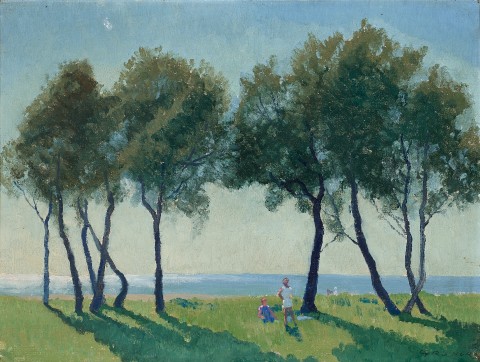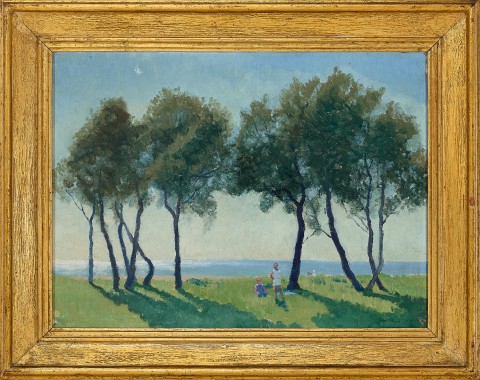Figures by the shore, c.1934
Elioth Gruner
oil on canvas on board
30.5 x 41.0 cm
signed lower right: GRUNER
Arthur Hancock, Melbourne
Thence by descent
Private collection, Melbourne
Thence by descent
Private collection, Melbourne
Beach idyll, 1934, oil on canvas on board, 46.5 x 44.0 cm, New England Regional Art Museum, New South Wales, gift of Howard Hinton
We are grateful to Steven Miller for his assistance with this catalogue entry.
As a teenager, Elioth Gruner was forced to take on family responsibility early due to the death of his father when he was very young, followed by that of his eldest brother when Gruner was sixteen. Such tragedies led to him working twelve-hour days as a draper’s assistant to support his mother whilst informally attending Julian Ashston’s art classes in the evening. This left little time for him to indulge in recreation – of which swimming and body surfing with close friends was a favoured pastime. The resultant paintings of these rare, hedonist moments are amongst the earliest sustained images depicting Australia’s love affair with the beach. Following World War One, Gruner’s focus turned inland, and it wasn’t until the 1930s that he returned to painting beaches and headlands, by which time he had perfected his mature, softly modernist style. Whilst these latter images were mostly de-populated, Figures by the shore, 1934, adds narrative intrigue with its two bathers looking back to the viewer whilst a third sits contemplating the ocean beyond.
Gruner’s early beach paintings coincided with a loosening of society’s rules regarding beach bathing; indeed, it was not until 1903 that bathers were officially allowed in the water during daylight hours. Gruner’s paintings between 1912 and 1918 are therefore additionally fascinating as his bathers are already within their environment, totally at home in the sand or water. In works such as Bondi Beach, c.1912 (Art Gallery of New South Wales), the clustered sunbathers have become ‘vibrant and economical studies in colour and tone (demonstrating) a new interest and facility in the simple arrangements of figures in patterns.1 This fascination with formalised design carries over into Figures by the shore with its classicist structure of the two main characters bracketed by trees; however, by placing these figures off centre, Gruner imparts a pleasing informality to the scene. The freshness of the brush marks also indicates that it was painted en plein air, in front of the motif.
Gruner suffered from depression and thus was not prolific, often destroying works he felt were not up to his exacting standards. In 1934, by contrast, he was buoyed by the previous year’s successes which included the magazine Art and Australia devoting an issue to his recent work, an act of public support which they had previously done to great acclaim in 1929. This positive affirmation continued when Gruner was awarded his fifth Wynne Prize in 1934 for Murrumbidgee Ranges, Canberra (National Gallery of Australia). In light of such events, it is tempting to detect a joyous purity within Figures by the shore, and in its companion work Beach idyll, 1934 (New England Regional Art Gallery). Whilst both are a welcome return to the figure-beach interaction, Gruner’s overall subject remains ‘the fine and subtle emotional quality of light (combined with a) feeling for design and form which (he) so courageously imposed on his work.’2
1. Clark, D., Elioth Gruner: Texture of light, Canberra Museum and Gallery, Australian Capital Territory, 2014, p. 17
2. Burdett, B., ‘The art of Daryl Lindsay’, Art in Australia, series 3, no. 39, August 1931, p. 23
ANDREW GAYNOR

